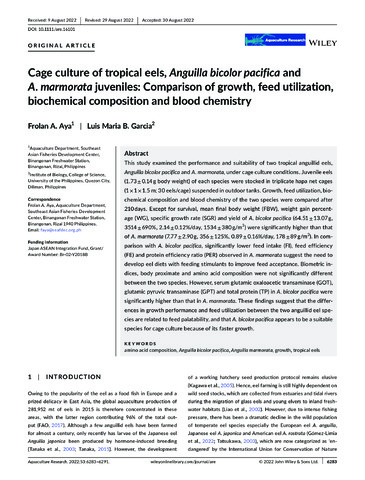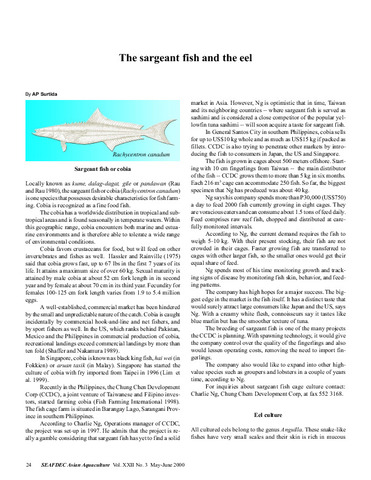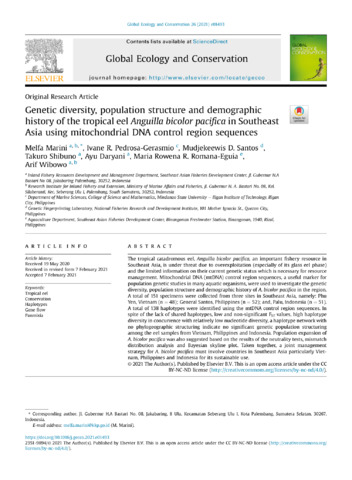| dc.contributor.author | Aya, Frolan | |
| dc.contributor.author | Unida, John Carlo L. | |
| dc.contributor.author | Romana-Eguia, Maria Rowena R. | |
| dc.contributor.author | Salayo, Nerissa D. | |
| dc.coverage.spatial | Philippines | en |
| dc.date.accessioned | 2023-09-13T01:24:37Z | |
| dc.date.available | 2023-09-13T01:24:37Z | |
| dc.date.issued | 2023-09 | |
| dc.identifier.citation | Aya, F. A, Unida, J. C. L., Romana-Eguia, M. R. R., & Salayo, N. D. (2023). Alternate day feeding as a cost-effective strategy for tank culture of the Pacific shortfin eel Anguilla bicolor pacifica. Philippine Agricultural Scientist, 106(3), 281-292. | en |
| dc.identifier.issn | 0031-7454 | |
| dc.identifier.uri | http://hdl.handle.net/10862/6487 | |
| dc.description.abstract | There is a growing interest in the aquaculture of tropical anguillid eels as an export commodity. However, studies on feeding strategies, and the present demand to reduce feed costs need to be addressed to ensure the economic viability of eel farming. In this study, the effects of daily (DF) and alternate day (ADF) feeding on growth, feed utilization, body composition, blood chemistry, liver and intestinal morphology, and economic viability in the Pacific shortfin eel Anguilla bicolor pacifica were examined. Each feeding group of 30 elvers (166.25 ± 16.23 g mean initial wt) were randomly stocked in triplicate 4 m3 outdoor concrete tanks. These were fed for 155 d with formulated eel powder diet (49.77% crude protein; 10.21% crude lipid) made into a paste. Growth and survival were not significantly different between the two feeding groups. However, feed efficiency was improved in the ADF group, with significantly higher protein efficiency ratio (0.63) than in the DF group (0.39). Feed conversion ratio (FCR) was lower in ADF (3.85) than in the DF group (6.44), resulting in a 40% reduction in total feed consumption. Biometric indices, body proximate composition, and blood chemistry were not significantly affected. Likewise, liver and intestinal morphology showed no apparent alterations between groups. Partial costs-and-returns analysis showed that ADF yielded higher net profit and profit index. These results suggest that feeding on alternate days promote compensatory growth, better feed utilization, and normal physiological condition of A. bicolor pacifica, and reduce feed cost in the rearing process. Therefore, alternate day feeding should be promoted as a sound feed management strategy in the tank culture of tropical anguillid eels. | en |
| dc.description.sponsorship | This study was supported by the Japan ASEAN Integration Fund (Br-02-Y2018B) and the Government of Japan-Trust Fund (8300-B-RD-FD0415 and 8300-B-RD-FD0120). | en |
| dc.language.iso | en | en |
| dc.publisher | College of Agriculture and Food Science, University of the Philippines Los Baños | en |
| dc.subject | eels | en |
| dc.subject | Anguilla bicolor | en |
| dc.subject.lcsh | Feed utilization efficiency | en |
| dc.title | Alternate day feeding as a cost-effective strategy for tank culture of the Pacific shortfin eel Anguilla bicolor pacifica | en |
| dc.type | Article | en |
| dc.citation.volume | 106 | en |
| dc.citation.issue | 3 | en |
| dc.citation.spage | 281 | en |
| dc.citation.epage | 292 | en |
| dc.citation.journalTitle | Philippine Agricultural Scientist | en |
| dc.subject.asfa | eel culture | en |
| dc.subject.asfa | feeding | en |
| dc.subject.asfa | feeding experiments | en |
| dc.subject.asfa | diet | en |
| dc.subject.asfa | water quality | en |
| dc.subject.asfa | proximate composition | en |
| dc.subject.asfa | morphology | en |
| dc.subject.asfa | feeds | en |
| dc.subject.asfa | histology | en |
| dc.subject.scientificName | Anguilla bicolor pacifica | en |
| dc.subject.scientificName | Anguilla bicolor | en |
| local.subject | blood chemistry | en |
| local.subject | feeding regimes | en |
| local.subject | growth metrics | en |
| local.subject | proximate composition | en |
| local.subject | Amalona | en |



